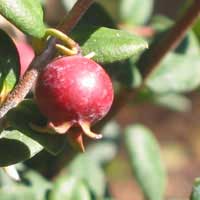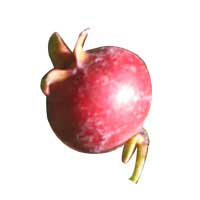 Full List of Fruits
Full List of Fruits  Ugni fruit
Ugni fruitUgni fruit
Scientific name - Ugni molinae
Recognized commonly by its regional names such as Chilean guava or strawberry myrtle, Ugni molinae is a shrub with evergreen foliage and it grows from 30 cm to 170 cm tall. Indigenous to Chile and neighboring regions of southern Argentina, the fruit is occasionally marketed as Ugniberry. In New Zealand, they are marketed as New Zealand cranberry. Cultivated to a small extent, in general, the fruit is small in size; say just about 1 cm diameter and these berries are red, white or purple in color. If cultivated in its natural habitat, (the Valdivian temperate rain forests) the fruit is said to mature in autumn from March to May. Though the handling of the fruit in cooking is limited to southern Chile where it grows, the fruits are processed in order to make jams and the Murta con membrillo dessert and in Kuchens.
![]() Nutritional Value of Ugni fruit
Nutritional Value of Ugni fruit
| Components | Amount |
|---|---|
| Moisture | 81.6g |
| Fat | <0.2g |
| Saturated fat | <0.2g |
| Protein | 0.9g |
| Ash | 0.6g |
| Carbohydrates | 17g |
| Energy (kJ) | 302kj |
| Fructose | 4.7g |
| Glucose | 3.2g |
| Sucrose | 1.8g |
| Maltose | <0.1g |
| Lactose | <0.1g |
| Total sugar | 9.7g |
| Vitamin C | 5.0mg |
Antioxidants present in the fruit is said to have a number of health-promoting benefits in people, counting:
 Reducing the risk of some cancers
Reducing the risk of some cancers
 Cardiovascular disease
Cardiovascular disease
 Development of cataracts
Development of cataracts
 Pathological disorders
Pathological disorders
 Gastric and duodenal ulcers
Gastric and duodenal ulcers
 Allergies
Allergies
 Vascular fragility
Vascular fragility
 Viral and bacterial infections
Viral and bacterial infections
Ugni molinae when cultivated in any reasonably good soil, they will grow well and this also includes the dry ones. When seen the personal preference, they are said to thrive well in a moderately fertile well-drained soil in a sunny position. It can withhold maritime exposure only to a certain extent; on the other hand, established plants are drought resistant. When fully dormant, they can endure temperatures down to about -10°c. Classified under the category of an ornamental plant, they are hardy in the milder parts of Britain. With all that said, plants from this species are outstandingly resistant to honey fungus. In case if young growth happens during the spring then chances are there that they can be damaged by late frosts. When the plants are its young stage, they flowers and fruits well.
In order to have the best of it, it is highly recommended that you pre-soak the seeds for a period of 24 hours in warm water and then disseminate it in late winter in a greenhouse. When they are large enough to handle, prick out the seedlings into individual pots and grow them on in a greenhouse for at least their first winter. During the late spring or early summer, planting them out into their permanent positions is said to help, subsequent to the last expected frosts.
Seeing that, Chilean guavas begin to fruit at quite a small size, this includes only just a few berries at first, but it profuse as they develop. Ripening at a snail's pace, typically early in winter, the berries are a real late season treat.


















